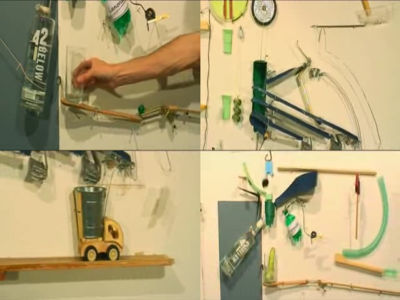A fierce man who makes an 'analog computer that predicts the tide level' appears in Lego

Lego blocks can be made into various things by combining a huge variety of parts, and there are also core users who make
Predicting the tide with an analog computer made from Lego --Wishful Coding
http://pepijndevos.nl/2022/01/30/predicting-the-tide-with-an-analog-computer-made-from-lego.html
Dutch software developer Pepijn the Fox (@pepijndevos) was inspired by a movie made with Lego of ' Antikythera mechanism ', which is said to be the oldest analog calculator in the world, and has a complicated mechanism. He said he decided to make a ' tide predictor' with Lego.
A tide predictor is a mechanical analog computer developed between the 19th and 20th centuries that was used to predict irregular sea level fluctuations. British scientist William Thomson (Sir Kelvin) , who developed the first tidal predictor , discovered that the Fourier transform could be applied to tidal motions to decompose tidal data into frequency components. Thomson has developed a mechanical analog computer that predicts the tide level at any point by applying harmonic analysis to frequency components based on tide data and combining multiple astronomical components.
This is the tide level predictor actually developed by Thomson. By adjusting the gears, it is possible to predict the tide according to the prediction point, and the result is converted into vertical movement and written on the paper at the bottom. It is said that this machine can record one year's worth of tidal movements in one port in about four hours.

by
Based on Thomson's basic idea, Pepijn the Fox decided to build a tide predictor by combining gears and pulleys that move at the right frequency. However, the big problem in making a tide predictor with Lego is that 'Because the size of Lego gears is fixed, it is not possible to create the optimum gear ratio with the smallest gear.'
To solve this problem, Pepijn the Fox wrote a script in a programming language called Julia and substituted the five astronomical frequency components listed on Wikipedia's Theory of tides page. The gear ratio to be used can be made relatively easily with Lego blocks. The calculation is narrowed down to '8:24', '12:20', '12:28' and '16:20', and the tide is predicted based on the result. He said he designed the machine.
The following 88 gear blocks are used for the tide predictor this time.

Pepijn the Fox said it was very difficult to combine all the gears as tightly as possible, especially when arranging orthogonal gears. After all, it took two days to combine these gears.

These parts were stacked alternately and connected with a long drive shaft and lever to complete the tide predictor.

You can see how the tide predictor created by Pepijn the Fox works in the following movie.
Predicting the tides with an analog computer made from Lego --YouTube
The gears rotate with a small noise, and the connected pulleys move slowly. The angle and distance of the motor indicate the predicted position of the tide, and the computer records the change in tide level over time.

The tide predictor made this time is designed to predict the tide level in Hawaii. The image below compares the data predicted by a modern computer with the tide level in Hilo Bay , Hawaii (top) and the result predicted by a tide predictor made with Lego (bottom). Although not all elements match, Pepijn the Fox said they are very similar.


Related Posts:







